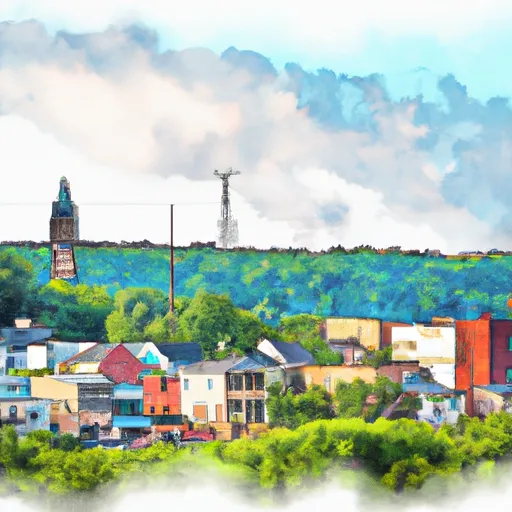-
 Snoflo Premium
Snoflo Premium
Get unlimited access to all our content
With no Ad interruptions! - Start Your Free Trial Login with existing account
Sturgeon
Eden Index
Climate
8.2
•
Recreation
2.8
•
Community
5.2
•
Safeguard
5.6/10

Sturgeon, Pennsylvania is a small borough located in Washington County. The climate in Sturgeon is characterized as a humid continental type, with warm summers and cold winters. The average temperature in summer ranges from 70°F to 85°F, while in winter, it can drop to an average of 20°F to 35°F. The region experiences moderate precipitation throughout the year, with rain being more frequent than snowfall.
Sturgeon is surrounded by several water bodies, including creeks and small rivers. These hydrological constituents provide opportunities for fishing, boating, and other water-based activities. You can explore the nearby Chartiers Creek or take a short drive to visit Peters Creek Lake, which offers fishing, kayaking, and scenic hiking trails.
For outdoor recreation, Sturgeon is in close proximity to parks and natural areas. Mingo Creek County Park, just a few miles away, features walking trails, picnic areas, and a lake for fishing and boating. Another nearby attraction is the Montour Trail, which offers a scenic route for walking, jogging, and biking.
In summary, Sturgeon, Pennsylvania boasts a humid continental climate, with varying temperatures throughout the year. Its hydrology constituents provide opportunities for fishing and water activities, while nearby parks and trails offer various outdoor recreational activities for nature enthusiasts.
What is the Eden Index?
The Snoflo Eden Index serves as a comprehensive rating system for regions, evaluating their desirability through a holistic assessment of climate health, outdoor recreation opportunities, and natural disaster risk, acknowledging the profound impact of these factors on livability and well-being.
Climate Health Indicator (CHI): 8.2
Sturgeon receives approximately
998mm of rain per year,
with humidity levels near 83%
and air temperatures averaging around
11°C.
Sturgeon has a plant hardyness factor of
6, meaning
plants and agriculture in this region thrive during a short period during spring and early summer. Most
plants will die off during the colder winter months.
By considering the ideal temperature range, reliable water supplies, clean air, and stable seasonal rain or snowpacks, the Climate Health Indicator (CHI) underscores the significance of a healthy climate as the foundation for quality living.
A healthy climate is paramount for ensuring a high quality of life and livability in a region, fostering both physical well-being and environmental harmony. This can be characterized by ideal temperatures, reliable access to water supplies, clean air, and consistent seasonal rain or snowpacks.
Weather Forecast
Streamflow Conditions
Upper Ohio-Beaver
Area Rivers
Upper Ohio-Beaver
Snowpack Depths
Upper Ohio-Beaver
Reservoir Storage Capacity
Upper Ohio-Beaver
Groundwater Levels
Recreational Opportunity Index (ROI): 2.8
The Recreational Opportunity Index (ROI) recognizes the value of outdoor recreational options, such as parks, hiking trails, camping sites, and fishing spots, while acknowledging that climate plays a pivotal role in ensuring the comfort and consistency of these experiences.
Access to outdoor recreational opportunities, encompassing activities such as parks, hiking, camping, and fishing, is crucial for overall well-being, and the climate plays a pivotal role in enabling and enhancing these experiences, ensuring that individuals can engage in nature-based activities comfortably and consistently.
Camping Areas
| Campground | Campsites | Reservations | Toilets | Showers | Elevation |
|---|---|---|---|---|---|
| Mason - Dixon Historical Park | None | 1,170 ft | |||
| Raccoon Creek State Park | None | 1,039 ft |
Nearby Ski Areas
Catastrophe Safeguard Index (CSI):
The Catastrophe Safeguard Index (CSI) recognizes that natural disaster risk, encompassing floods, fires, hurricanes, and tornadoes, can drastically affect safety and the overall appeal of an area.
The level of natural disaster risk in a region significantly affects safety and the overall livability, with climate change amplifying these risks by potentially increasing the frequency and intensity of events like floods, fires, hurricanes, and tornadoes, thereby posing substantial challenges to community resilience and well-being.
Community Resilience Indicator (CRI): 5.2
The Community Resilience Indicator (CRI) recognizes that education, healthcare, and socioeconomics are crucial to the well-being of a region. The CRI acknowledges the profound impact of these elements on residents' overall quality of life. By evaluating educational resources, healthcare accessibility, and economic inclusivity, the index captures the essential aspects that contribute to a thriving community, fostering resident satisfaction, equity, and social cohesion.

